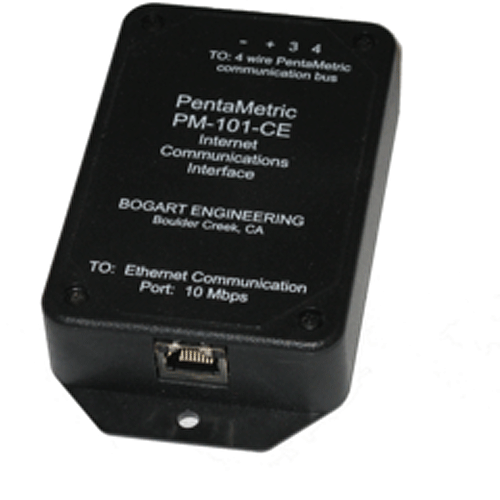Home / Shop / Controllers / Meters/Monitors
Bogart Engineering PM-101-CE Pentametric Ethernet Interface


- Description
Bogart Engineering
PentaMetric Battery Monitoring System
Ethernet Interface
PM-101-CE
The PentaMetric Ethernet Interface (PM-101-CE) connects to the 4 wire bus from the PentaMetric input device, and connects to a router or computer by an Ethernet cable. It allows you to read all the data including the logged data and program all PentaMetric functions from a remote location through the internet. The remote computer must have a Windows operating system with PMComm software (available as a free download from our web site.) The PMComm program allows viewing of up to 6 items of data simultaneously on the screen.
You must have a local static internet address at the location of the PentaMetric system. Also, it requires version 2.0 or greater of the PentaMetric input unit (This can be identified by removing the cover from the Input unit and looking for the chip that has the white label that shows, for example, "V. 2.0F".) If you do not have this version, it can be upgraded for a small charge.
The PentaMetric Battery Monitoring System consists of 3 Possible Components (each ordered separately):
- PentaMetric Input Unit (PM-5000-U) - Used to collect, process and log data (near batteries). Required component.
- PentaMetric Display Unit (PM-100-D) - optional readout unit with LCD display and control buttons (wired connection up to 1000')
- Computer Interface Unit - choose 1 of 3 optional interfaces to read output data
- PM-100-C Computer Interface: optional RS232 computer interface with software to control and read out all data
- PM-102-C-USB USB Computer Interface: optional USB computer interface with software to control and read out all data
- PM-101-CE Ethernet Computer Interface: optional Ethernet/internet computer interface with software to control and read out all data.
Please Note: Data may be simultaneously accessed and controlled using the Display Unit and/or any one of the three computer interface options.
The new PentaMetric battery monitor system offers a lot more capability than the TriMetric monitor. The PentaMetric would be the choice for doing system data analysis utilizing a computer.
Features
- It measures 1 or 2 battery systems with a common negative.
- With one battery system, battery current plus two charging current sources can be separately measured. Two voltages can be measured. Watts, watt hours and amp hours are also measured.
- It has a optional computer interface with (Windows) software that can control and read data on a local computer, or also over the internet.
- It can log data that can be imported to a spreadsheet and graphed to analyze performance and diagnose system problems. System efficiency (ratio of amp hours charged to amp hours discharged for each charge cycle) is regularly logged.
- Monitor up to 3 shunts--For example: measure total solar input and wind input independently in addition to monitoring battery "state of charge"
- Access the data with display unit (shown) with LCD display and buttons up to 1000 feet from batteries.
- Relay output to control generator or external alarm
- Audible and visual alarms for high and low battery conditions
Real Time Measurement Capability
Basic measurements:
Volts: (2 channels) 8-100 volts. For example you can monitor volts from two battery systems. Or battery voltage, plus the solar array voltage if you have a peak power point tracking controller.
Amps: (3 channels) ±.01-200 Amps (with 100A/100mV shunt).± 0.1-1000 Amps (with 500A/50mV shunt) Each of these requires a separate shunt. There are many different ways these can be used. For example one channel can be used to keep track of battery system energy content and the two remaining ones can be used for separate measurement of two charging sources, such as total solar or wind production. Or two battery systems can be separately monitored if they share a common negative connection--and in addition one charging source could be separately monitored.
Temperature: -20 to +65 degrees C.
Secondary measurements derived from basic measurements:
Amp hour: (3 channels) to ±83,000 Amp-hours
Cumulative (negative) battery amp hours:(2 channels) to -1,000,000 amp-hours
This measures accumulated amp hours (usually from a battery) only when the amps value is negative. Its purpose is to measure the total cumulative 'wear' of batteries during their lifetime.
Smoothed (time filtered) Amps:with time constants of 0.5, 2 or 8 minutes (3 channels) ±.01-200 Amps (100A/100mV shunt).± 0.1-1000 Amps (500A/50mV shunt)
For example, this can be used to show a more accurage estimate of wind charging input when the wind source is varying in speed.
Smoothed (time filtered) Volts:(2 channels) 0-100 Volts. The smoothed values for both Amps and Volts are used for triggering "alarm" and relay functions so very short term anomolies will be ignored.
Watts:(2 channels) ±.01- 20,000 watts
Watt-hours:(2 channels) ±21,000 kilowatt hours
Battery %full:(2 channels) 0-100%
Days since batteries charged: (2 channels) .01-250 days
Days since batteries equalized: (2 channels) .01-250 days
Data logging functions
There are 3 types of data logging functions. With the computer interface all 3 types can be output to spreadsheet file.
- "Periodically logged data" can record any or all of the following at regular intervals: once per day to up to once per minute
- Amp hours (3 channels)
- Watt hours (2 channels)
- Temperature max/min (1 channel)
- Volts (2 channels)
- Amps (1 channel)
- Batt%Full (2 channels)
- "Periodically logged data" can record any or all of the following at regular intervals: once per day to up to once per minute
- "Battery discharge voltage profile" data logs volts and amps every time charge level changes by 5% (or 10%) for 1 or 2 battery systems. This checks that battery capacity is still OK--by observing that battery voltage does not decline excessively as charge level drops.
- "Battery cycle efficiency data" documents system efficiency for up to 2 battery systems. For each 'charge/discharge' cycle it records: cycle length (hours), total amp hours charged, total amp hours discharged, computed average 'self discharge' current and charge (amp hour) efficiency.
Controls and alarms
Relay output: Control external relay to go on and off at specified voltage levels and/or battery state of charge levels. "On" and "Off" levels can be independently set.
Audible and visual alarms
Has audible or visual signal for 'Low voltage or low state of charge', 'High voltage', 'battery is charged', 'too many days since charged', and 'too many days since equalized'.
Warranty: The Bogart Engineering warranty policy is to repair at no cost any of their products that develop a problem not due to customer misuse.
